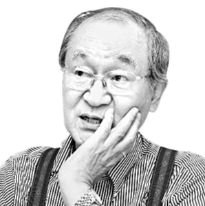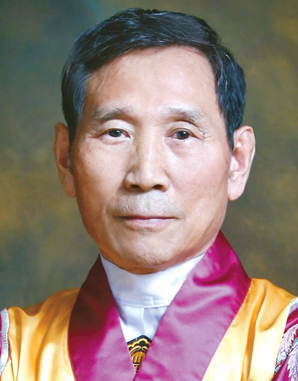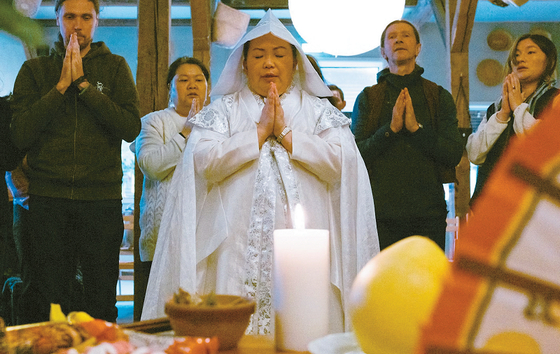
대만의 정씨 왕조는 4대에 걸쳐 대만에서 청나라와 항쟁하는 역사를 지녔는데 정성공의 선조들에 대한 언급은 중국 역사에서 찾기 정말 어려웠다. 그래서 그에 대한 해답은 越에 있을 것으로 생각하고 찾아보니 解讀新發現的鄭成功族譜,『廈門晚報』,2002年6月30日 것을 보니 "先祖是鄭榮, 父是鄭瑢(西庭,另一說鄭王容), 父是鄭士表(另一說鄭紹祖),字毓程,號象廷,福建泉州府南安石井鄉人." 라고 기재되어 있었다. 즉, 정영(鄭榮)이 그 가계의 시조라는 것이다. 정성공의 정씨는 복건이 토종이 아닌 정성공의 조부인 정사표(鄭士表) 대에 이주했다는 것이다. 정영(鄭榮)은『越南通史』에 의하면 베트남 후 레 왕조의 외척 정씨(鄭氏) 정옥창(鄭玉蒼) 가문의 4대 손으로 나오는데 정검(鄭檢)과는 사촌 간으로 나와 있다. 이 가계가 좀 복잡한데 앞서 언급한 것을 세세히 밝혀보도록 한다. 베트남 후 레 왕조의 외척 정씨(鄭氏) 정옥창(鄭玉蒼)은 명나라를 격파한 뒤 베트남 후 레 왕조를 건국했던 베트남의 대표적 영웅 레 로이(黎利)의 모친이다.
그녀는 레 로이가 후 레 왕조를 건국하자 정자황태후(Trinh Từ Hoàng thái hậu/貞慈皇太后) 로 추존된다. 이후 그녀의 가문은 후 레 왕조의 정사에 합류하게 된다. 레 로이의 정실 황후인 공자황태후(Cung Từ Hoàng thái hậu/恭慈皇太后)가 1425년 사망하자 레 로이는 다시 황후를 세워야 하는 상황으로 나타나게 되자 자신의 어머니 가문인 정씨(鄭氏) 가문의 정옥창(鄭玉蒼)의 고종사촌 정류(鄭柳/Trịnh Liễu)의 딸인 정옥여(鄭玉呂/Trịnh Thị Lữ)를 황후로 맞이하게 된다. 그녀는 신비(Thần phi/宸妃) 라고 불리며 레 로이의 정실이 된다. 레(黎)씨 가문이 어떤 가문인가? 치우천왕이 다스렸던 구려국(九黎國)의 후예로써 상고시대 황제헌원과 전쟁 이후, 묘족과 함께 남하했던 동이족의 일족이었다. 필자는 베트남 연구하면서 누누히 말해왔다. 黎족은 치우제를 지내고 그 여족의 중시조가 전 레 왕조를 건국했던 레 호안(黎桓)이고 두 번째 중시조가 후 레 왕조를 건국했던 레 로이(黎利)라고 말이다. 내가 연구하고 있는 동남아시아 해양 역사고고학 연구소가 베트남 타이빈(太平) 레 로이(黎利) 마을에 있다고 말이다. 그 레 로이와 정씨(鄭氏)는 그렇게 인연이 된다.
정류(鄭柳/Trịnh Liễu)는 태국공(太國公) 정검(鄭檢/Trịnh Kiểm)의 증조부인데 그가 베트남의 후 레 왕조의 분열기의 북쪽 왕조를 담당했던 찐 왕조(鄭王朝)의 시조인 鄭 世祖(1545년~1570년)가 되는데 당시는 후 레 왕조가 분열의 시기로 북방의 찐(鄭) 왕조와 남방 막(莫) 왕조로 갈라져 있었다. 이 찐(鄭) 왕조는 상권이 매우 뛰어나 국가 자체의 경제를 육, 해상 상업에 주로 종사시켰는데 정지룡의 아버지인 정사표(鄭士表)가 찐(鄭) 왕조의 황족으로써 복건으로 이주했던 것으로 보인다. 정사표(鄭士表)의 고향이『台灣外紀』에서는 교지국(交趾國) 출신으로 기록하고 있어 정지룡의 가문이 본래 해적 출신이 아니라 베트남 중세 왕조인 찐(鄭) 왕조의 황족인 것이 입증되고 있는 것이다.
정사표(鄭士表)에게서 1604년 정성공의 아버지인 정지룡이 태어났고 정지룡은 광동, 대만, 복건, 광서, 북베트남에 이르기까지 해상상권을 장악했으며 멀리 유구국, 일본까지 왕래했던 거상(巨商)이자 해적으로 활약했던 것이다. 그리고 일명 남중국 바다의 왕자라 불리기도 한다. 정성공의 부친 정지룡은 이단의 상단에서 대만과 중국 해안을 연결하는 무역을 맡았다. 중국 해안에서 교역항을 찾던 네덜란드는 포르투갈의 마카오를 침공했지만 실패했고, 정지룡을 통해 명나라 조정에 항구 하나 내어달라고 요청했다. 명나라 조정과 네덜란드 사이를 오가며 협상을 중재한 정지룡은 네덜란드에게 중국 해안은 불허하니, 대만에 가서 요새를 짓고 무역항으로 활용하라고 권한다. 이후 네덜란드가 1624년 대만 타이난(臺南)에 요새를 지으니, 젤란디아 요새(Fort Zeelandia)다. 이 곳은 나중에 정지룡의 아들 정성공이 점령해 왕국을 세우고 수도로 삼게 된다.
정지룡 일당은 포모사(Formosa, 대만의 옛 이름)의 최대 밀수꾼이었다. 명나라는 조공 이외의 사무역을 일절 허용하지 않았기 때문에 중국해안을 떠나 외국과 거래를 하는 행위는 모두 밀무역으로 금지되어 있었다. 정성공의 어릴 때 이름은 일본식으로 후쿠마쓰(福松)였다. 어머니 다가와와 함께 히라도에서 어렵게 살았다. 생활비는 아버지 정지룡이 가끔 보내주었다고 한다. 그러던 중 정지룡의 아버지인 정사표가 세상을 떠났다. 계모와 정을 통한 죄로 집을 떠났던 정지룡은 정사표의 죽음을 계기로 고향인 샤먼(厦門)으로 들어가 지역 원수가 되었다. 정지룡은 가문의 사업을 이어받은데다 이단 휘하의 세력도 손에 넣어 중국 남동부 해안의 실력자가 되었다. 그는 이단 상단의 2인자인 안사제(顔思齊)의 딸과 결혼해 상단의 지위를 강화했다. 그러던 중에 1625년 8월 12일 정지룡의 보스 이단이 히라도에서 사망했다.
정지룡은 이단 상단을 장악하기 위해 반대파들과 전쟁에 돌입했다. 도적질한 자금으로 선박을 사들이고 선원들을 고용했다. 더 이상 네덜란드와의 중계무역을 하는 상인이 아니라, 무장선단의 선장으로 나섰다. 그는 마닐라로 가는 스페인 선박을 나포해 화물과 보화를 탈취했다. 해가 갈수록 정지룡의 해적질은 꽤 잘 나가는 사업이 되었다. 1626년에 정지룡은 자신의 뒤를 봐준 네덜란드인에게 28,000냥 상당의 도자기와 물자가 가득 실린 선박 9척을 선물로 주기도 했다. 그로 인해 정지룡은 대만과 복건성 사이의 항로를 장악하게 된다. 정성공은 아버지의 궁궐에서 15살까지 새 어머니와 새 형제들과 함께 살았다. 그는 공부에 전념했다. 춘추(春秋)와 같은 역사서는 물론 무예도 닦았다. 17세가 되던 1611년 정성공은 부인을 맞게 된다. 부인은 부유한 동(董)씨 가문의 딸 취잉이었다.
그들은 결혼하자 곧바로 아들을 낳아 집안의 후사를 이었다. 정지룡은 40세도 안된 나이에 할아버지가 된 것이다. 청나라 순치제(順治帝)가 5살에 황제로 즉위하자, 삼촌인 도르곤(多爾袞)이 섭정을 맡아 실권을 행사했다. 명(明)나라 마지막 황제 숭정제는 난을 일으킨 이자성에 나라를 내어주고 자결했다. 1643년 명나라 유신 오삼계는(吳三桂)는 도르곤에게 산해관을 열어주고 청군과 함께 이자성의 무리들을 쫓아 갔다. 명나라의 황족들은 남쪽으로 내려가 나라를 다시 일으키니 남명(南明)이라 했다. 남명 정권 수립에 결정적 역할을 한 인물은 정지룡이었다. 정지룡은 당시 나이 41세로 한 때 밀수업에 몸담아 큰 재력을 형성한 성공한 상인이자 무인으로, 중국 남동부 해안의 선대를 장악한 해양 군벌로 군림하고 있었다. 정지룡은 남명 정권의 킹메이커나 다름 없었다. 그의 개인 재산은 당시 몇몇 나라의 부(富)보다 많아 오직 그 혼자만이 앞으로 닥칠 남명 정권의 저항운동에 자금을 댈 수 있었다.
남명 정권을 수립한 홍광제(弘光帝)는 명나라의 유신들에게 새로운 귀족과 장수들을 임명하면서, 정지룡에겐 남안백(南安伯)이라는 벼슬을 내리고 남경 방어를 지원하라고 명했다. 남경은 양자강을 지키는 중요한 거점이었다. 하지만 남경도 오래 버티지 못했다. 남명의 조정은 더 남하해 정지룡의 거점인 복건성으로 이동해왔다. 홍광제는 사망하고 융무제(隆武帝)가 새로 즉위했다. 복건성으로 이동한 남명 정권은 정씨에게 더 매달렸다. 홍광제는 정지룡에게 평노후라는 작위를 봉하고 군사문제를 관장하는 3개 부처의 통솔권을 주었다. r그러나 청나라의 공작에 넘어간 정지룡은 남명 황제를 배신하고, 적이었던 청나라에 충성을 맹세했다. 남명의 한족 국가는 멸망의 위기에 놓였을 때 새로운 영웅을 만났으니, 그가 바로 정지룡의 아들 정성공이다. 정성공은 망한 명나라를 부흥시키려고 끝까지 청나라에 저항한 인물이었다.
그는 1658년 7월 10만이 넘는 병력과 크고 작은 전함 수십 척을 이끌고 다른 항청(抗淸) 군대와 연합하여 북벌을 시작했다. 북벌군은 우여곡절 끝에 난징 턱밑까지 진격했고 그 주변 지역의 항청 분위기는 고조되었다. 그러나 승리에 도취하여 상대의 전력을 무시한 정성공은 청나라의 기습을 받아 측근 장수 감휘(甘輝)가 전사하는 등 대패하고 말았다. 청나라 군은 복건성에서 남은 정씨 세력의 거점인 안해성(安海城)을 공격했다. 그 때 정성공은 안해성에 없었고, 그의 생모인 다가와가 지키고 있었다. 다가와는 정지룡을 따라가지 않았다. 청군이 공격할 때 다가와는 일본 사무라이 집안의 딸답게 가만히 앉아서 죽음을 맞지 않았다. 그녀는 칼을 들고 성루에 올라가 병사들과 함께 만주족과 전투를 벌였다. 화염에 쌓인 첨탑에서 다가와의 마지막 모습이 비쳤는데, 그녀는 단도로 자신의 목을 찌르고 아래 해자로 몸을 던졌다고 목격자들은 전했다. 정성공은 어머니의 사망 소식을 듣고 정신줄을 놓았다고 한다.
남명의 마지막 황제 융무제도 도망을 가다가 사로잡혔다. 반청운동을 하던 정성공은 안정된 요충지로 대만을 점찍고 그곳으로 가기로 했다. 하지만 그곳에 정착하려면 네덜란드인들이 자리를 비켜주어야 했다. 네덜란드와의 전투는 불가피했다. 1661년 4월 21일 정성공의 대만 원정함대는 복건을 떠났다. 규모는 전함 900척, 병력 25,000명이었다. 정씨 함대는 쉽게 팽호도를 점령했지만, 젤란디아 요새의 네덜란드 군은 완강하게 버텼다. 병력수는 정씨측에서 10배 이상이었지만, 젤란디아 성은 요새인데다 네덜란드군은 현대식 포대를 갖추고 있었다. 전투는 무려 9개월을 끌었다. 해를 넘겨 1662년 2월 1일 완전히 고립되어 물자 보급이 어려워지자 네덜란드 군이 평의회 의결을 거쳐 마침내 항복문서에 조인했다.
그 대신 네덜란드 군인들이 무장한 채 깃발을 흔들고 북 소리와 함께 영광스럽게 철수하는 조건이었다. 그러자 정성공은 이를 허가했다. 하지만 네덜란드 인은 만주족에 투항한 한족처럼 거짓으로 속이지 않았다. 네덜란드 인들이 떠나자 정성공은 적감성(赤嵌城)으로 들어가 새로운 나라를 세웠다. 그런 정성공은 죽어서 대만의 신(神)이 되었다. 그것도 모든 대만인이 복덕(福德)을 비는 존재로 남게 되면서 신으로써의 면모가 더욱 가중되었다.
*필자/ 정길선.
노바토포스 회원, 역사학자, 고고인류학자, 칼럼니스트, 러시아 과학아카데미 유라시아 고고인류학연구소 연구교수.
*아래는 위 기사를 '구글 번역'으로 번역한 영문 기사의 [전문]입니다. '구글번역'은 이해도 높이기를 위해 노력하고 있습니다. 영문 번역에 오류가 있을 수 있음을 전제로 합니다.<*The following is [the full text] of the English article translated by 'Google Translate'. 'Google Translate' is working hard to improve understanding. It is assumed that there may be errors in the English translation.>
The Second Story of Zheng Zhilong, the Prince of the Sea, and Zheng Chenggong's Anti-Qing Restoration Movement
-Columnist Zheng Gil-seon
The Zheng Dynasty of Taiwan has a history of fighting against the Qing Dynasty in Taiwan for four generations, but it is really difficult to find any mention of Zheng Chenggong's ancestors in Chinese history. So I thought the answer to that would be in Yue, and when I looked it up, I found the newly developed Jeong Cheng-gong clan genealogy, 『Jeonmun Evening News』, dated June 30, 2002, which states, "Ancestor is Jeong Rong, father is Jeong Yu (Xiting, also known as Jeong Wang-rong), father is Jeong Shi-pyo (also known as Jeong Shao-jo), courtesy name Yu-cheng, pen name Xiang-ting, from Shijing Village, Nan'an, Quanzhou Prefecture, Fujian." In other words, Jeong Rong is the progenitor of that family. It is said that Zheng Zheng's Zheng clan was not a native of Fujian, but migrated during the generation of Zheng Shibiao (鄭士表), Zheng Zheng's grandfather. According to the "Vietnam General History," Zheng Rong (鄭榮) is the fourth generation descendant of the Zheng clan (鄭氏) Zheng Yuchang (鄭玉蒼) of the Le Dynasty of Vietnam, and is listed as a cousin of Zheng Jian (鄭檢). This family lineage is a bit complicated, so let's look into the details mentioned above. Zheng Zheng (鄭氏) Zheng Yuchang (鄭玉蒼), the maternal relative of the Le Dynasty of Vietnam, is the mother of Le Loi (黎利), a representative Vietnamese hero who defeated the Ming Dynasty and founded the Le Dynasty of Vietnam. She was honored posthumously as Empress Dowager Trinh Từ Hoàng thái hậu (貞慈皇太后) when Lê Loi founded the Later Lê Dynasty. Her family later joined the Later Lê Dynasty. When Le Loi's first wife, Empress Dowager Cung Từ Hoàng thái hậu/恭慈皇太后, died in 1425, Le Loi was faced with the situation of having to choose another empress. He chose Zheng Yu Lu (鄭玉呂/Trịnh Thị Lữ), the daughter of Zheng Yuchang (鄭玉蒼) of the Zheng family (鄭氏), his mother's family, and Zheng Liu (鄭柳/Trịnh Liễu), his first cousin. She was called Shin Bi (宸妃) and became Le Loi's first wife. What kind of family is the Le family? They were descendants of the Goryeo Kingdom (九黎國) ruled by Chiyou Heavenly King, and after the war with Emperor Xuanyuan in ancient times, they were a clan of the Dongyi people who moved south with the Miao people. I have said this many times while studying Vietnam. The Li people held the Chiyou Emperor, and the middle ancestor of the Li people was Le Hoan (黎桓), who founded the former Le Dynasty, and the second middle ancestor was Le Loi (黎利), who founded the later Le Dynasty. The Southeast Asian Maritime Archaeological Research Institute, where I am studying, is located in Le Loi (黎利) Village, Thai Binh (太平), Vietnam. That is how Le Loi and the Jeong clan (鄭氏) became related. Jeong Liu (鄭柳/Trịnh Liễu) was the great-grandfather of Prince Trịnh Kiểm (太國公). He became the founder of the Trinh Dynasty (1545-1570), which was in charge of the northern dynasty of the Later Le Dynasty in Vietnam. At that time, the Later Le Dynasty was in a period of division, splitting into the Trinh Dynasty in the north and the Mac Dynasty in the south. The Trinh Dynasty had excellent commercial power and focused its national economy on land and sea commerce. It seems that Jeong Si-pyo (鄭士表), the father of Jeong Ji-rong, immigrated to Fujian as a member of the Trinh Dynasty's royal family. The hometown of Zheng Shibiao (鄭士表) is recorded in the 『台灣外紀』 as being from the state of Jiaozi (交趾國), which proves that Zheng Zhilong's family was not originally from pirates, but was the royal family of the Trinh Dynasty, a medieval dynasty in Vietnam.
Zheng Shibiao (鄭士表) gave birth to Zheng Zhenggong's father, Zheng Zhilong, in 1604. Zheng Zhilong controlled the maritime trade from Guangdong to Taiwan, Fujian, Guangxi, and northern Vietnam, and was active as a merchant and pirate who traveled as far as Ryukyu and Japan. He is also called the Prince of the South China Sea. Zheng Zhenggong's father, Zheng Zhilong, was in charge of trade between Taiwan and the Chinese coast at the Yidan Trading Company. The Dutch, who were looking for a trading port on the Chinese coast, invaded Macau in Portugal, but failed, and requested the Ming court to grant them a port through Zheng Zhilong. Zheng Zhilong, who mediated negotiations between the Ming court and the Netherlands, advised the Dutch to go to Taiwan and build a fortress and use it as a trading port, as the Chinese coast was not allowed. Later, in 1624, the Dutch built a fortress in Tainan, Taiwan, called Fort Zeelandia. This place was later occupied by Zheng Zhilong's son, Zheng Chenggong, who established a kingdom and made it the capital. Zheng Zhilong and his gang were the biggest smugglers in Formosa (the old name for Taiwan). Since the Ming dynasty did not allow any private trade other than tribute, any act of leaving the Chinese coast and trading with foreign countries was prohibited as smuggling. Zheng Zhenggong's childhood name was Fukumatsu (福松) in Japanese. He lived a difficult life in Hirado with his mother, Tagawa. It is said that his father Zheng Zhilong occasionally sent him living expenses. Then, Zheng Zhilong's father, Zheng Shibiao, passed away. Zheng Zhilong, who had left home due to his stepmother's affair, returned to his hometown of Xiamen (厦門) and became a local leader after Zheng Shibiao's death. Zheng Zhilong inherited his family's business and also took control of the forces under Yidan, becoming a powerful figure on the southeastern coast of China. He married the daughter of Yan Siji (顔思齊), the second-in-command of Yidan, and strengthened the status of Yidan. Then, on August 12, 1625, Zheng Zhilong's boss Yidan died in Hirado.
Zheng Zhilong went to war with his opponents in order to take control of Yidan. He bought ships and hired sailors with the money he had stolen. He was no longer a merchant engaged in intermediary trade with the Netherlands, but instead became the captain of an armed fleet. He captured Spanish ships heading to Manila and stole their cargo and treasure. As the years passed, Zheng Zhilong's piracy became a very successful business. In 1626, Zheng Zhilong gave nine ships loaded with porcelain and supplies worth 28,000 taels to the Dutch who supported him. This gave Zheng Zhilong control over the shipping route between Taiwan and Fujian. Zheng Zhenggong lived with his stepmother and stepbrothers in his father's palace until he was 15. He devoted himself to his studies. He studied historical books such as the Spring and Autumn Annals and also practiced martial arts. In 1611, when he was 17, Zheng Zhenggong took a wife. She was the daughter of the wealthy Dong family, Chuying. They soon had a son after their marriage, and Zheng Zhilong became a grandfather at the age of 40. When the Shunzhi Emperor of the Qing Dynasty ascended the throne at the age of 5, his uncle Dorgon assumed the regency and exercised real power. The last emperor of the Ming Dynasty, Chongzhen, gave up his country to Li Zicheng, who had started a rebellion, and committed suicide. In 1643, Wu Sangui, a Ming vassal, opened Shanhai Pass to Dorgon and pursued Li Zicheng's men with the Qing army. The Ming imperial family went south to rebuild the country, which was called the Southern Ming. The person who played a decisive role in the establishment of the Southern Ming regime was Zheng Zhilong. Zheng Zhilong was 41 years old at the time. He was a successful merchant and military man who had amassed great wealth through smuggling, and he was a maritime warlord who controlled the fleets along the southeastern coast of China. Zheng Zhilong was practically the kingmaker of the Southern Ming regime. His personal wealth was greater than that of several countries at the time, and he alone could finance the resistance movement against the Southern Ming regime that was to come. Hongguang Emperor, who established the Southern Ming regime, appointed new nobles and generals to the Ming vassals, and gave Zheng Zhilong the title of Nan'an Bo (南安伯) and ordered him to support the defense of Nanjing. Nanjing was an important stronghold guarding the Yangtze River. However, Nanjing did not last long. The Southern Ming court moved further south to Fujian, Zheng Zhilong's stronghold. After Hongguang Emperor died, Longwu Emperor (隆武帝) ascended the throne. The Southern Ming regime that moved to Fujian depended more on the Zheng family. Hongguang Emperor gave Zheng Zhilong the title of Marquis of Pingno and gave him command of three ministries in charge of military affairs. However, Zheng Zhilong, who fell for the Qing's scheme, betrayed the Southern Ming emperor and pledged allegiance to the Qing, which was their enemy. When the Han Chinese state of Southern Ming was on the verge of collapse, it met a new hero, Zheng Zhenggong, Zheng Zhilong's son. Zheng Chenggong was a man who resisted the Qing until the end in order to revive the fallen Ming Dynasty.
In July 1658, he led over 100,000 troops and dozens of large and small warships, and joined forces with other anti-Qing forces to launch the Northern Expedition. The Northern Expedition forces advanced to the edge of Nanjing after many twists and turns, and the anti-Qing atmosphere in the surrounding areas was heightened. However, Zheng Chenggong, intoxicated with victory and ignoring the enemy's strength, was attacked by the Qing and suffered a crushing defeat, including the death of his close aide, Gan Hui. The Qing army attacked Anhai Castle, the remaining stronghold of the Zheng clan in Fujian Province. At that time, Zheng Chenggong was not in Anhai Castle, and his biological mother, Da Ga-wa, was guarding it. Da Ga-wa did not follow Zheng Zhilong. When the Qing army attacked, Da Ga-wa, like the daughter of a Japanese samurai family, did not sit still and face death. She went up to the castle with her sword and fought the Manchus with her soldiers. The last image of her was seen from the spire engulfed in flames, and witnesses reported that she stabbed herself in the neck with a dagger and threw herself into the moat below. It is said that Zheng Chenggong lost his mind after hearing the news of his mother's death.
The last emperor of the Southern Ming Dynasty, Longwu Emperor, was captured while trying to escape. Zheng Chenggong, who was leading the anti-Qing movement, decided to go to Taiwan, which he considered a stable strategic point. However, in order to settle there, the Dutch had to give up their position. A battle with the Dutch was inevitable. On April 21, 1661, Zheng Chenggong's Taiwan expedition fleet left Fujian. It consisted of 900 warships and 25,000 men. The Zheng fleet easily captured Penghu Island, but the Dutch forces at Fort Zeelandia held out stubbornly. The Zheng forces outnumbered them by more than ten to one, but Fort Zeelandia was a fortress and the Dutch forces had modern artillery. The battle lasted a full nine months. On February 1, 1662, when the Dutch army was completely isolated and supplies were difficult to obtain, the Dutch army finally signed the surrender document after a council vote.
Instead, the Dutch soldiers were to withdraw gloriously, armed, waving flags and beating drums. Then Zheng Chenggong allowed it. However, the Dutch did not deceive the Manchus like the Han Chinese who surrendered to them. When the Dutch left, Zheng Chenggong entered Chihkan Castle and founded a new country. After his death, Zheng Chenggong became a god in Taiwan. His godly image was further aggravated as he became a being whom all Taiwanese prayed for blessings.
lukybaby7@gmail.com
*Author/ Jeong Gil-seon.
Novatopos member, historian, paleoanthropologist, columnist, research professor at the Institute of Eurasian Paleoanthropology, Russian Academy of Sciences.
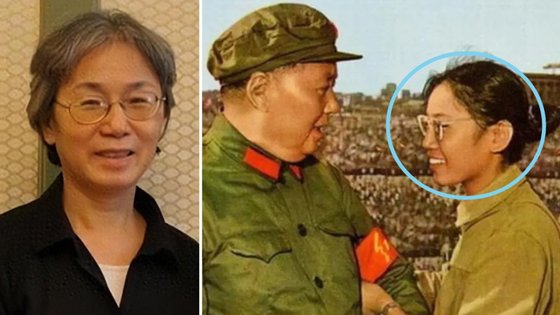
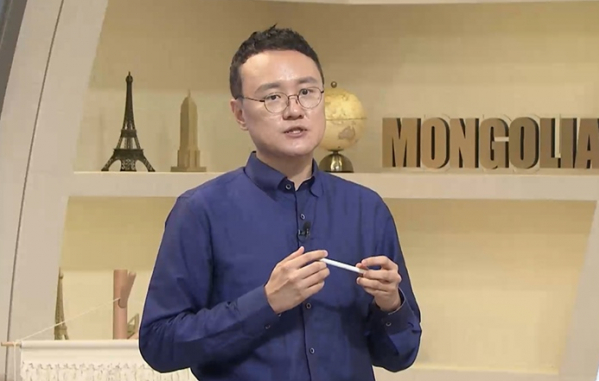
![[대구논단] 우리는 언제쯤 퇴임 후에도 존경받는 대통령을 가질 수 있나](https://www.idaegu.co.kr/news/photo/202409/2024091901000539600031691.jpg)

